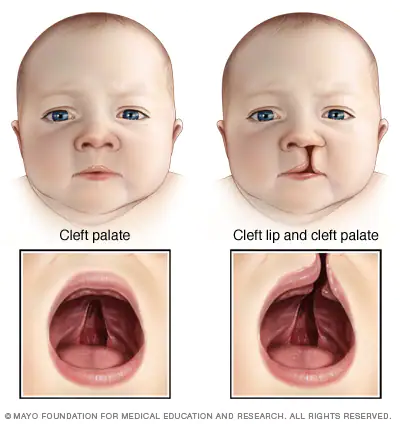According to the Cleft Palate Foundation, one of every 600 newborns is affected by cleft lip and/or cleft palate. Cleft palate is a congenital, or birth, defect that is characterized by an opening in the roof of the mouth in which the two sides of the palate did not fuse during the development of an unborn baby.
I Had a Cleft Palate — Will My Child Have One, Too?
Cleft palate develops during the very early stages of pregnancy, and can be attributed to a combination of genetic and environmental factors. So if you had a cleft palate that doesn’t necessarily mean your unborn child will develop one, too.
In fact, scientists have determined that the chances of a cleft palate recurring is dependent upon a variety of factors, including the number of persons affected in your family, the closeness of affected relatives, the race and sex of all affected persons and the severity of the cleft.
The Cleft Palate Team
A child born with a cleft palate is treated by a team of several different specialists. Cleft palate treatment can include a variety of procedures, including cleft palate surgery, orthodontic dental care and speech therapy, and occurs in a coordinated effort over a period of years.
A cleft palate team may be comprised of:
General dentist — A thorough dental exam by the age of 1 is recommended for children with a cleft condition. An early evaluation can help determine what special dental needs the child might have, since a cleft condition can sometimes be related to missing teeth, malformed or malpositioned teeth.
Orthodontist — An orthodontic evaluation may be scheduled before a child’s teeth begin to erupt. One of the primary goals of orthodontic care for children with cleft conditions is to monitor jaw growth and bite problems. Following surgery, an orthodontist may be required to create an orthodontic retainer or dental braces.
Oral surgeon — Oral surgery may include a variety of coordinated procedures, including a tooth extraction, restorations and palate reconstruction. In some cases, the oral surgeon can reconstruct the palate with a bone graft. After a bone graft, the child may need to wear a retainer and then a full set of braces.
Prosthodontist — The help of a prosthodontist may be required to create a dental bridge or oral appliance called a “speech bulb” or “palatal lift.” These treatments are designed to help a child eat, speak and look better, and are synchronized with the efforts of both the oral surgeon and speech therapist.
Speech pathologist/therapist — After surgery, a speech pathologist will assess a child’s communication skills to help determine what speech exercises are necessary, or whether further surgery is required. Many children who have clefts work with a speech therapist throughout their grade-school years.
Separating Fact From Fiction
Contrary to popular belief, cleft conditions have no relation to mental retardation. However, a learning disability can be present if a cleft palate or cleft lip occurs in conjunction with a group of disorders or a syndrome.
The term harelip is often used to describe a cleft lip. But it is a misnomer and viewed as derogatory by professionals. “Harelip” actually refers to a rabbit, which has a natural indentation on the center of its lip that looks similar to a cleft lip.
If your child was born with a cleft palate, an initial visit to a general or pediatric dentist can get them started on their dental treatment.

